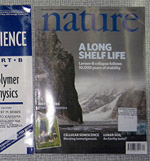Dam removal vs. exotic species control: the benefit for native fish
 Fish,
Fish,  Freshwater,
Freshwater,  Invasive,
Invasive,  Restoration
Restoration  Fossil Creek near Strawberry, Arizona.Scientists have turned a dam decommissioning on a stream in Arizona into an ecological experiment. They wanted to study the relative merits of flow restoration and invasive species removal in helping native fish. They found that while both measures improved native fish populations, the impact of invasive species removal was much greater and less expensive.
Fossil Creek near Strawberry, Arizona.Scientists have turned a dam decommissioning on a stream in Arizona into an ecological experiment. They wanted to study the relative merits of flow restoration and invasive species removal in helping native fish. They found that while both measures improved native fish populations, the impact of invasive species removal was much greater and less expensive.
Restoration is often seen as a solution to many of the problems that streams face: habitat alteration, invasive species, declining water quality. In the US projects ranging from dam removal to exotic species control have cost upwards of $10 billion in the past decade. Yet as the study authors from Northern Arizona University note, fewer than one-tenth of such projects monitor their results. Moreover, until recently, no studies have compared the cost effectiveness of flow restoration and the removal of exotic fish.
Habitat Restoration Conducted as an Ecological Experiment
The study in the journal Restoration Ecology collected data on fish species diversity and abundance in separate reaches of Fossil Creek before and after the dam decommissioning. Each reach underwent a different experimental treatment:
- Control (with no diversion and non-native fish absent)
- Flow restored in an area without non-native fish
- Flow restored and non-native fish removed
- Flow restored and non-native fish remain
The only treatment this study was not able to address was that of non-native fish removal without flow restoration.
Six months pior to restoring flow, the poison antimycin was applied to remove exotic fish - primarily smallmouth bass (Micropterus dolemie) and green sunfish (Loepomis cyanellus) - after first salvaging native species. A drop barrier resembling a natural waterfall was built to prevent exotic fish recolonization of the treatment area. Native fish were returned to the stream subsequent to treatment.
Data on the relative abundance of native versus non-native fish pre- and post-treatment were used to compare the results from each of the four treatments.
Benefits of Exotic Fish Removal Outweigh Benefits of Flow Restoration
The study showed that both flow restoration and exotic removal increased native fish but the relative impacts differed:
- In the reach without prior existing exotic fish, flow restoration increased native fish 3-fold.
- The treatment with exotic fish removal and flow restoration increased native fish almost 50-fold.
- The treatment with flow restoration but no removal of exotic fish had no effect on native species.
This particular decommissioning cost approximately $12.3 million, while the exotic fish removal added $1.1 million to the price tag. The researchers conducted a simple cost-benefit analysis based on these figues and the native fish population increases in response to the two treatments (assuming the effects were additive) They found that exotic fish removal added significant value to the project, calculating a yield of 3.6 native fish recovered per $1000 of exotic fish removal compared to .08 recovered per $1000 of flow restoration alone.
The Implications of Ecosystem Complexity for Dam Decommissioning
Previous studies have suggested a general mechanism in which exotic fish force native fish to eat poorer quality food (at a lower trophic level), a finding confirmed in this research through stable isotope analysis of food web structure in Fossil Creek. The authors of this study point out the need for an ecosystem perspective in planning and conducting habitat restoration. They state
“it is possible that interventions reverse one disturbance but create or exacerbate others.”
Examples from the literature of such missteps include:
- Sediments released from behind dams can reduce native filter feeders.
- Drained reservoirs may be more vulnerable to exotic plant invasion.
- Removal of non-native fish can facilitate invasions of other exotic species such as crayfish.
In fact, the authors point out the very real danger that in Fossil Creek, dam removal without the exotic fish eradication (and barrier) might have allowed exotic fish to invade upstream reaches that were previously inaccessible to them. They conclude,
“Habitat improvements alone may do little for native fish recovery where exotic fish dominate the fish assemblages.”
--Reviewed by Gregg Elliott
Marks, J., Haden, G., O’Neill, M., & Pace, C. (2009). Effects of Flow Restoration and Exotic Species Removal on Recovery of Native Fish: Lessons from a Dam Decommissioning Restoration Ecology DOI: 10.1111/j.1526-100X.2009.00574.x




Reader Comments